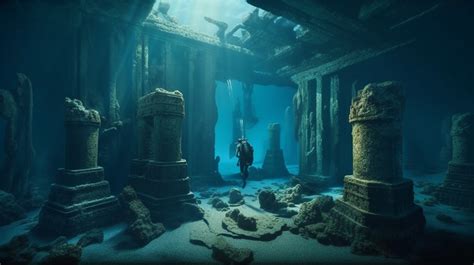
Submerged prehistoric landscapes off the coast of Australia, containing stone tools, provide the earliest known evidence of human habitation in the area and suggest that ancestors of Indigenous Australians lived in now-underwater habitats tens of thousands of years ago.
Underwater archaeological discoveries off the Pilbara coast of Western Australia have revealed evidence of ancient human settlements, offering unprecedented insights into the lives of early Indigenous Australians and their adaptation to changing environments. These findings, published in the journal Quaternary Science Reviews, showcase submerged landscapes containing thousands of artifacts, including stone tools, indicating that these areas were once habitable terrestrial environments before being submerged by rising sea levels. The research, led by archaeologists from Flinders University, James Cook University, and other institutions, provides a compelling glimpse into the lives of early coastal populations and their resilience in the face of dramatic environmental shifts.
The discoveries represent a significant step forward in understanding the deep history of Indigenous Australians. While previous studies have suggested the potential for submerged archaeological sites along the Australian coastline, concrete evidence has been scarce. This new research presents tangible proof of human occupation in these submerged landscapes, pushing back the timeline of human presence in the region and highlighting the importance of coastal areas in the early history of the continent.
“Today, we announce the discovery of two underwater archaeological sites found in the Pilbara region of Western Australia at Cape Bruguieres and Dampier Archipelago,” said Associate Professor Jonathan Benjamin, Maritime Archaeology, Flinders University, in a statement to the press. “This evidence represents the earliest known archaeological sites on Australian seafloor.”
The submerged landscapes hold well-preserved artifacts, including stone tools such as flakes, scrapers, and ground-edge axes. Analysis of these tools indicates that they were used for a variety of tasks, including hunting, gathering, and processing food. The presence of ground-edge axes, in particular, is significant because these tools are typically associated with more settled lifestyles and the processing of plant materials, suggesting that the early inhabitants of these coastal areas were developing increasingly sophisticated technologies.
The two primary sites of the study, located at Cape Bruguieres and the Dampier Archipelago, were identified through a combination of advanced seabed mapping, remotely operated vehicle (ROV) surveys, and diver investigations. The researchers used high-resolution sonar to create detailed maps of the seafloor, identifying areas with unusual features that could potentially be archaeological sites. ROVs were then deployed to further investigate these areas, capturing video and images of the seabed. Finally, divers were sent to the most promising locations to collect artifacts and conduct more detailed surveys.
At Cape Bruguieres, researchers discovered a freshwater spring located 2.4 meters below mean sea level. Around the spring, they found hundreds of stone artifacts, indicating that this was a focal point for human activity. The artifacts were found embedded in sediment layers that date back to at least 7,000 years ago, suggesting that the site was occupied during a period when sea levels were significantly lower than they are today.
At the Dampier Archipelago, the researchers identified a submerged island that was once part of the mainland. On the island, they found evidence of a stone quarry and a workshop where tools were manufactured. The artifacts found at this site are older than those at Cape Bruguieres, dating back to at least 9,000 years ago. This discovery provides valuable insights into the technological capabilities of early Indigenous Australians and their ability to adapt to changing environmental conditions.
The submerged landscapes investigated in this study were once part of a vast coastal plain that extended far beyond the present-day shoreline. During the Last Glacial Maximum, around 20,000 years ago, sea levels were much lower than they are today, exposing vast areas of land that are now submerged. As the climate warmed and the ice sheets melted, sea levels began to rise, gradually inundating these coastal plains. The rising sea levels forced early human populations to adapt and migrate, either moving inland or developing new technologies to exploit marine resources.
The preservation of archaeological sites in submerged environments is often better than on land, due to the protective effects of the water and sediment. Submerged sites are less exposed to erosion, weathering, and human disturbance, allowing artifacts to remain in their original context for thousands of years. This provides archaeologists with a unique opportunity to study the past and gain insights into the lives of early human populations.
One of the key challenges in underwater archaeology is locating and excavating submerged sites. The researchers involved in this study used a variety of techniques to overcome these challenges, including advanced seabed mapping, ROV surveys, and diver investigations. They also worked closely with Indigenous communities to ensure that their research was conducted in a culturally sensitive and respectful manner. The collaboration with Indigenous communities is crucial for the success of underwater archaeology in Australia, as these communities have a deep connection to the land and sea and possess invaluable knowledge about the past.
The discovery of submerged archaeological sites off the coast of Australia has significant implications for our understanding of human history. It provides tangible evidence of human occupation in these landscapes, pushing back the timeline of human presence in the region and highlighting the importance of coastal areas in the early history of the continent. These findings also underscore the need to protect and manage submerged cultural heritage sites, which are vulnerable to damage from natural processes and human activities.
The research team hopes to continue exploring the submerged landscapes off the coast of Australia, searching for more evidence of early human settlements. They also plan to conduct further analysis of the artifacts they have already discovered, in order to gain a deeper understanding of the lives of early Indigenous Australians. The discoveries off the coast of Western Australia add to a growing body of evidence that suggests that submerged landscapes around the world hold valuable clues about human history. As technology improves and underwater archaeology becomes more sophisticated, we can expect to see many more discoveries of submerged sites in the years to come.
The study authors emphasize the importance of recognizing submerged cultural heritage as a vital part of Australia’s history and advocate for greater efforts to protect and manage these sites. They argue that submerged archaeological sites are not only important for understanding the past, but also for informing present-day conservation and management strategies. By studying how early human populations adapted to changing environments, we can gain valuable insights into how to address the challenges of climate change and sea-level rise today.
The research was supported by various funding sources, including the Australian Research Council, the National Geographic Society, and the Western Australian Museum. The researchers also received invaluable assistance from Indigenous communities, who shared their knowledge and insights about the past. The success of this project demonstrates the importance of collaboration between scientists, Indigenous communities, and other stakeholders in the pursuit of knowledge and the protection of cultural heritage.
“This is another piece of the puzzle of human history and how humans lived on the Australian continent in that past,” said Associate Professor Sean Ulm, Deputy Director of the ARC Centre of Excellence for Australian Biodiversity and Heritage, James Cook University.
The Dampier Archipelago is known as Murujuga to the local Aboriginal people. It is a place of immense cultural significance, containing one of the world’s largest and most diverse collections of rock art. The submerged landscapes surrounding Murujuga are also believed to hold significant archaeological potential, and the recent discoveries confirm this belief.
The researchers are working closely with the Murujuga Aboriginal Corporation to ensure that their research is conducted in a culturally sensitive and respectful manner. They are also committed to sharing their findings with the community and incorporating Indigenous knowledge into their research. This collaborative approach is essential for ensuring that the past is studied in a way that benefits both science and Indigenous communities.
The discovery of submerged archaeological sites off the coast of Australia is a testament to the resilience and adaptability of early human populations. It also highlights the importance of protecting and managing submerged cultural heritage sites, which are vulnerable to damage from natural processes and human activities. As technology improves and underwater archaeology becomes more sophisticated, we can expect to see many more discoveries of submerged sites in the years to come, providing us with a deeper and more complete understanding of human history.
The discoveries prompt the question: How much more evidence of early human civilization lies beneath the waves, awaiting discovery? The answer, according to researchers, is likely a great deal. As sea levels rose dramatically over the past tens of thousands of years, vast stretches of coastline were submerged, potentially preserving countless archaeological sites. These submerged landscapes represent a largely untapped resource for understanding human history, and their exploration is only just beginning.
Frequently Asked Questions (FAQ)
1. What did the study find off the coast of Western Australia?
The study discovered submerged prehistoric landscapes containing stone tools off the Pilbara coast of Western Australia at Cape Bruguieres and the Dampier Archipelago, providing the earliest known evidence of human habitation in the area. These finds suggest that ancestors of Indigenous Australians lived in now-underwater habitats tens of thousands of years ago. “This evidence represents the earliest known archaeological sites on Australian seafloor,” said Associate Professor Jonathan Benjamin.
2. How old are the artifacts discovered, and what do they tell us about early Indigenous Australians?
The artifacts discovered at Cape Bruguieres date back to at least 7,000 years ago, while those found at the Dampier Archipelago are even older, dating back to at least 9,000 years ago. These stone tools, including flakes, scrapers, and ground-edge axes, indicate that early Indigenous Australians were skilled hunters, gatherers, and toolmakers who adapted to changing environmental conditions and developed sophisticated technologies. The presence of ground-edge axes also suggests more settled lifestyles and the processing of plant materials.
3. What methods did the researchers use to locate and study the submerged archaeological sites?
The researchers used a combination of advanced seabed mapping, remotely operated vehicle (ROV) surveys, and diver investigations to locate and study the submerged archaeological sites. High-resolution sonar was used to create detailed maps of the seafloor, identifying areas with unusual features. ROVs were then deployed to further investigate these areas, capturing video and images. Finally, divers were sent to the most promising locations to collect artifacts and conduct more detailed surveys.
4. Why are submerged archaeological sites important for understanding human history?
Submerged archaeological sites offer a unique window into the past because they are often better preserved than sites on land, due to the protective effects of the water and sediment. Submerged sites are less exposed to erosion, weathering, and human disturbance, allowing artifacts to remain in their original context for thousands of years. This provides archaeologists with a valuable opportunity to study the lives of early human populations and gain insights into their adaptations to changing environments.
5. What is the significance of this discovery for Indigenous communities and the protection of cultural heritage?
The discovery of submerged archaeological sites off the coast of Australia has significant implications for Indigenous communities, as it provides tangible evidence of their ancestors’ presence in these landscapes. The researchers worked closely with Indigenous communities to ensure that their research was conducted in a culturally sensitive and respectful manner. The study also underscores the need to protect and manage submerged cultural heritage sites, which are vulnerable to damage from natural processes and human activities. “This is another piece of the puzzle of human history and how humans lived on the Australian continent in that past,” said Associate Professor Sean Ulm.
Expanded Context and In-Depth Analysis
The discovery of submerged archaeological sites off the coast of Western Australia is not an isolated event but rather part of a growing trend in archaeological research. As technology improves and underwater exploration becomes more accessible, archaeologists are increasingly turning their attention to submerged landscapes around the world. These submerged environments hold immense potential for uncovering new evidence about human history and prehistory, offering a unique perspective on how early human populations adapted to changing environments and migrated across the globe.
The Pilbara region of Western Australia, where these submerged sites were discovered, is already known for its rich archaeological record. The region is home to Murujuga (the Dampier Archipelago), which contains one of the world’s largest and most diverse collections of rock art. The rock art at Murujuga provides valuable insights into the beliefs, practices, and social structures of early Indigenous Australians. The discovery of submerged archaeological sites in the surrounding waters adds another layer to this rich cultural heritage, providing a more complete picture of the region’s past.
The rising sea levels that submerged these coastal plains were a major environmental challenge for early human populations. As the ice sheets melted and sea levels rose, coastal communities were forced to adapt or migrate. Some populations may have moved inland, abandoning their coastal settlements. Others may have developed new technologies to exploit marine resources, such as boats, fishing nets, and other tools. The archaeological record provides evidence of both of these strategies, showing that early human populations were highly adaptable and resilient in the face of environmental change.
The study of submerged archaeological sites can also provide valuable insights into the impact of climate change on human societies. By studying how early human populations responded to rising sea levels in the past, we can gain a better understanding of the challenges that coastal communities face today and develop more effective strategies for adapting to climate change in the future.
The discovery of submerged archaeological sites off the coast of Australia highlights the importance of protecting and managing submerged cultural heritage. Submerged sites are vulnerable to a variety of threats, including natural processes such as erosion and sedimentation, as well as human activities such as fishing, dredging, and construction. Without proper protection, these sites can be damaged or destroyed, resulting in the loss of valuable information about the past.
The management of submerged cultural heritage requires a collaborative approach involving scientists, Indigenous communities, government agencies, and other stakeholders. It is essential to develop strategies for protecting these sites that are both effective and culturally sensitive. This may involve establishing marine protected areas, regulating fishing and other activities, and educating the public about the importance of submerged cultural heritage.
The collaboration between scientists and Indigenous communities is particularly important for the success of submerged archaeology in Australia. Indigenous communities have a deep connection to the land and sea and possess invaluable knowledge about the past. By working closely with Indigenous communities, archaeologists can gain a better understanding of the cultural significance of submerged sites and ensure that their research is conducted in a respectful and ethical manner.
The discoveries off the coast of Western Australia add to a growing body of evidence that suggests that submerged landscapes around the world hold valuable clues about human history. Similar discoveries have been made in other parts of the world, including Europe, Asia, and the Americas. These discoveries are transforming our understanding of human prehistory and highlighting the importance of protecting and managing submerged cultural heritage.
In Europe, for example, archaeologists have discovered evidence of submerged settlements in the North Sea, the Baltic Sea, and the Mediterranean Sea. These sites date back to the Mesolithic and Neolithic periods, providing insights into the lives of early farmers and hunter-gatherers. In Asia, archaeologists have discovered submerged cities and ports off the coasts of China, India, and Japan. These sites provide evidence of the development of maritime trade and the spread of civilization. In the Americas, archaeologists have discovered submerged caves and sinkholes in Mexico and Belize. These sites contain evidence of early human occupation and provide insights into the peopling of the Americas.
As technology improves and underwater archaeology becomes more sophisticated, we can expect to see many more discoveries of submerged sites in the years to come. These discoveries will provide us with a deeper and more complete understanding of human history, revealing new insights into the lives of our ancestors and the challenges they faced. They will also help us to better protect and manage our cultural heritage, ensuring that these valuable resources are preserved for future generations.
The research emphasizes the interconnectedness of land and sea in shaping human history. The submerged landscapes off the coast of Australia were once part of a vast coastal plain that supported a thriving human population. As sea levels rose, these landscapes were gradually inundated, forcing early human populations to adapt and migrate. The study of these submerged landscapes provides a unique perspective on the complex interactions between humans and the environment, highlighting the importance of understanding these interactions in order to address the challenges of climate change and sea-level rise today.
The discoveries also underscore the importance of interdisciplinary collaboration in archaeological research. The study of submerged archaeological sites requires expertise in a variety of fields, including archaeology, geology, oceanography, and remote sensing. By bringing together experts from different disciplines, researchers can gain a more comprehensive understanding of the past.
The ethical considerations surrounding underwater archaeology are also paramount. The disturbance of submerged sites must be carefully managed to minimize damage to artifacts and the surrounding environment. Collaboration with Indigenous communities is essential to ensure that research is conducted in a culturally sensitive and respectful manner. The knowledge gained from underwater archaeology should be shared with the public to promote a greater understanding of human history and the importance of cultural heritage.
The future of underwater archaeology is bright. As technology continues to advance, new tools and techniques are being developed that will allow archaeologists to explore submerged landscapes with greater precision and efficiency. These advances will undoubtedly lead to new discoveries that will further enhance our understanding of human history.
The exploration of submerged landscapes is not just about uncovering the past; it is also about informing the future. By studying how early human populations adapted to changing environments, we can gain valuable insights into how to address the challenges of climate change and sea-level rise today. The lessons of the past can help us to build a more sustainable and resilient future for all.
In addition to the specific sites mentioned in the original article, there are likely many other submerged archaeological sites along the Australian coastline that remain undiscovered. The Australian coastline is vast and complex, with a wide range of submerged environments, from shallow coastal waters to deep ocean trenches. The potential for further discoveries is enormous.
The search for submerged archaeological sites is a challenging but rewarding endeavor. It requires a combination of scientific expertise, technological innovation, and cultural sensitivity. By working together, scientists, Indigenous communities, and other stakeholders can unlock the secrets of the submerged past and gain a deeper understanding of human history.
The findings not only contribute to our understanding of early human occupation in Australia but also resonate with global research on submerged prehistoric sites. Similar discoveries have been made in other parts of the world, such as Doggerland in the North Sea, which was once a large landmass connecting Britain to continental Europe. These submerged landscapes provide evidence of early human settlements and offer valuable insights into the lives of our ancestors.
The study also highlights the importance of preserving and protecting submerged cultural heritage sites. These sites are vulnerable to damage from natural processes, such as erosion and sea-level rise, as well as human activities, such as fishing and dredging. It is crucial to implement effective management strategies to ensure that these sites are preserved for future generations.
The collaboration between researchers and Indigenous communities is essential for the success of underwater archaeology in Australia. Indigenous communities have a deep connection to the land and sea and possess invaluable knowledge about the past. By working together, researchers and Indigenous communities can ensure that archaeological research is conducted in a culturally sensitive and respectful manner.
The discoveries prompt further research into the submerged landscapes surrounding Australia. Researchers are eager to explore other potential sites and to conduct more detailed analyses of the artifacts that have already been discovered. These studies will provide a more comprehensive understanding of the lives of early Indigenous Australians and their adaptation to changing environments.
In summary, the discovery of submerged archaeological sites off the coast of Western Australia is a significant achievement that sheds new light on the early history of Indigenous Australians. The findings underscore the importance of underwater archaeology as a tool for understanding human prehistory and highlight the need to protect and manage submerged cultural heritage sites. The research also demonstrates the value of collaboration between scientists and Indigenous communities in the pursuit of knowledge and the preservation of cultural heritage.
The submerged landscapes are a testament to the deep history of Indigenous Australians and their connection to the land and sea. By studying these sites, we can gain a greater appreciation for the resilience and adaptability of early human populations and the importance of protecting our cultural heritage. The ongoing research promises to reveal even more about the submerged past and to contribute to a deeper understanding of human history.
Further exploration of these sites and others like them will continue to refine our understanding of human migration patterns, technological innovations, and adaptations to changing environments. The submerged landscapes are a valuable resource for researchers and a powerful reminder of the deep connection between humans and the sea.









